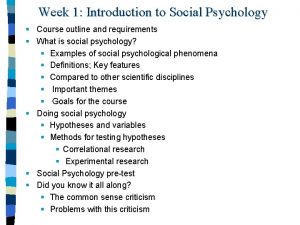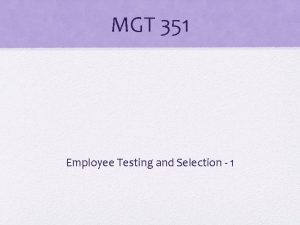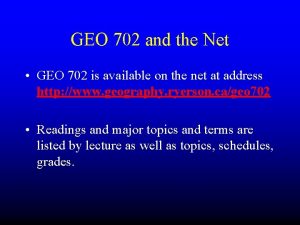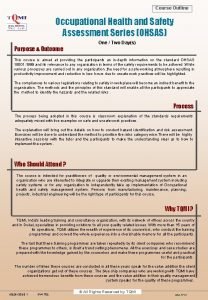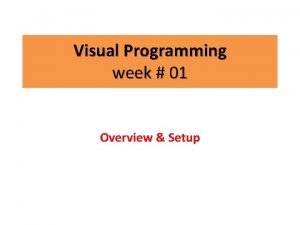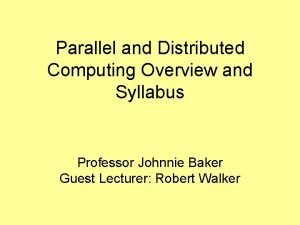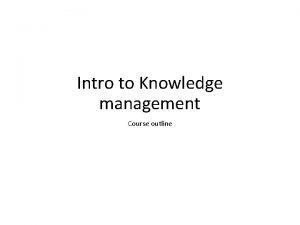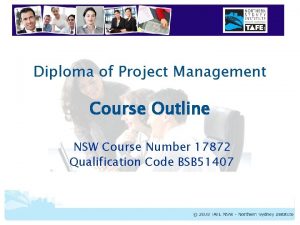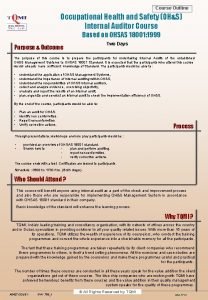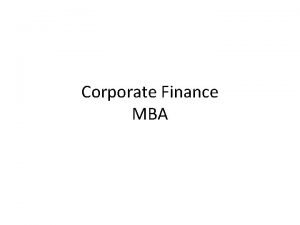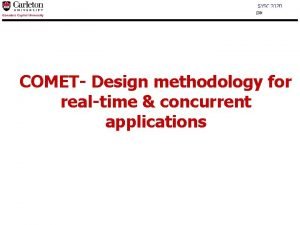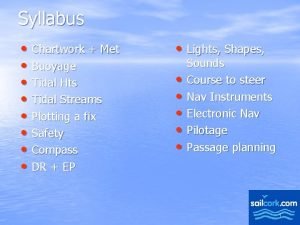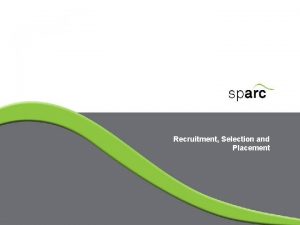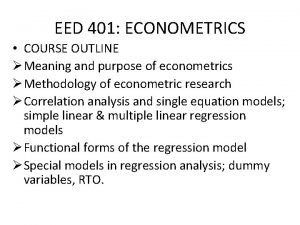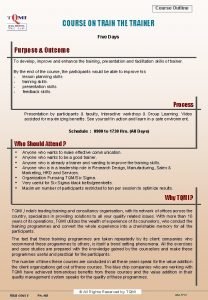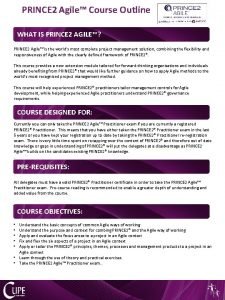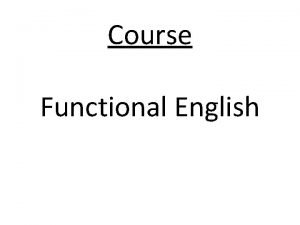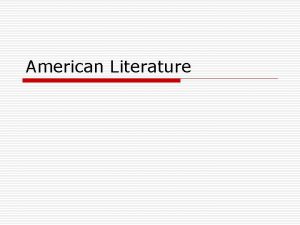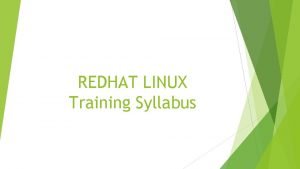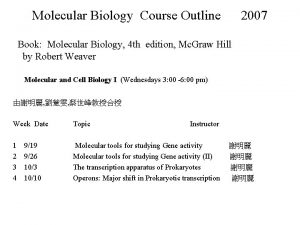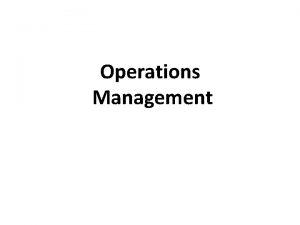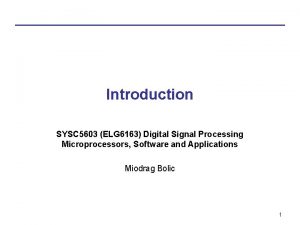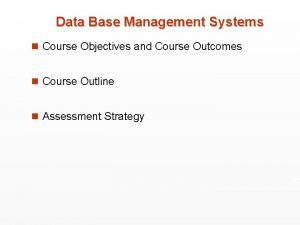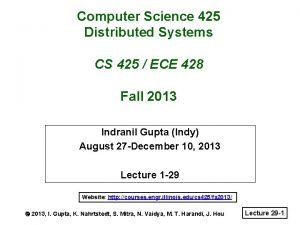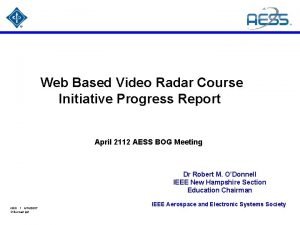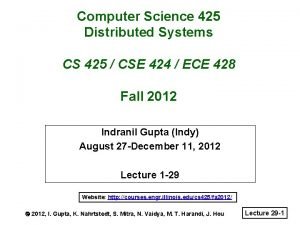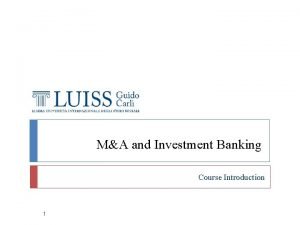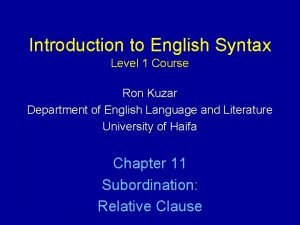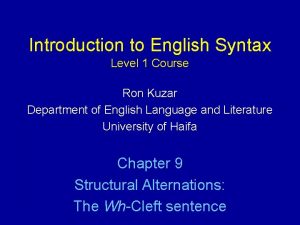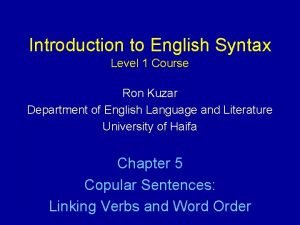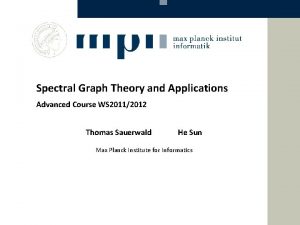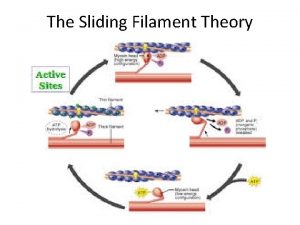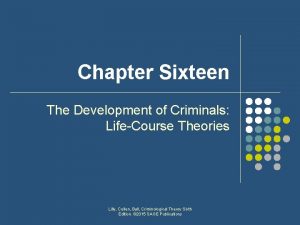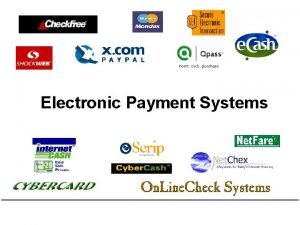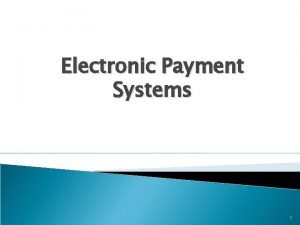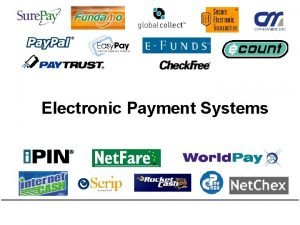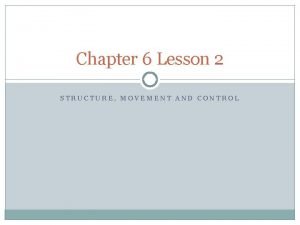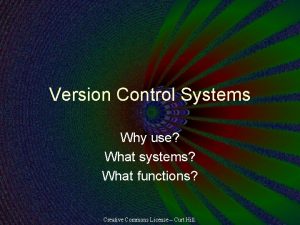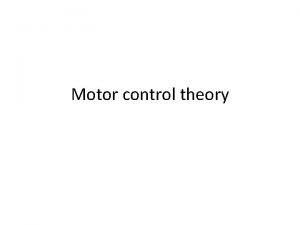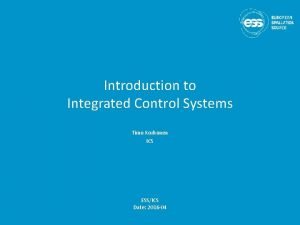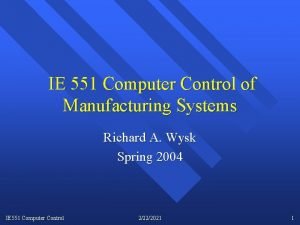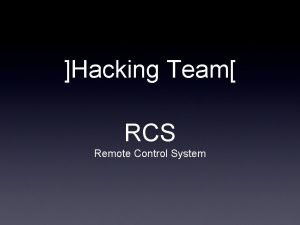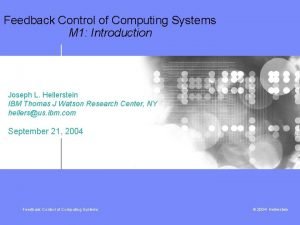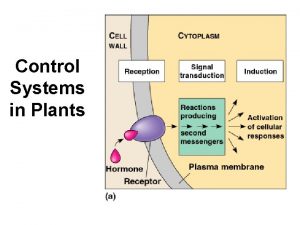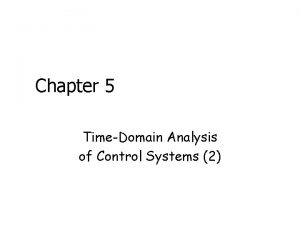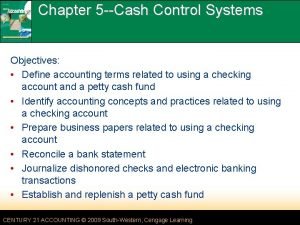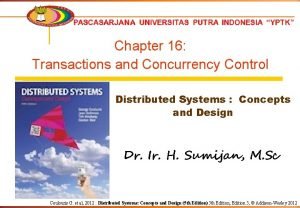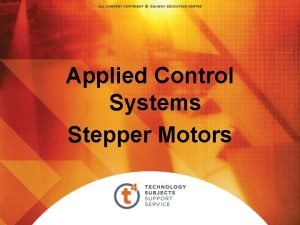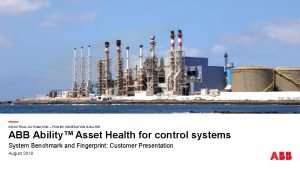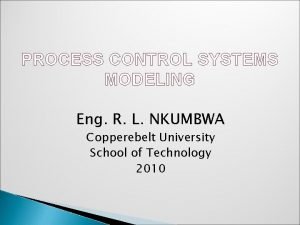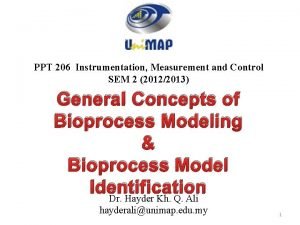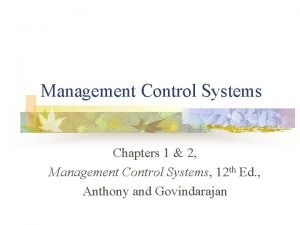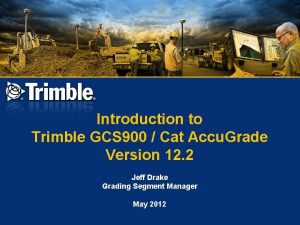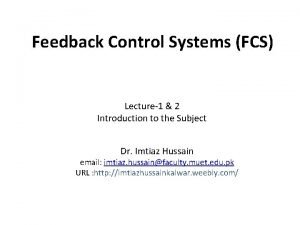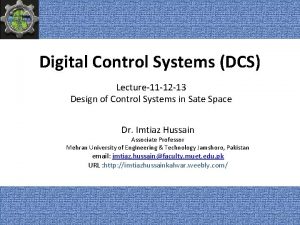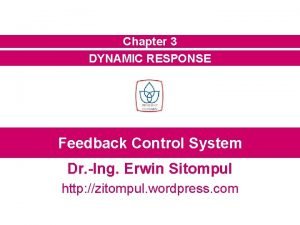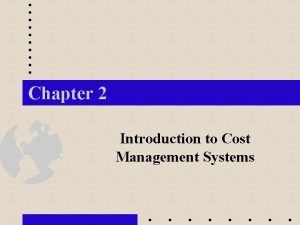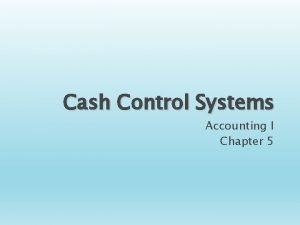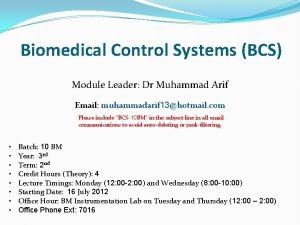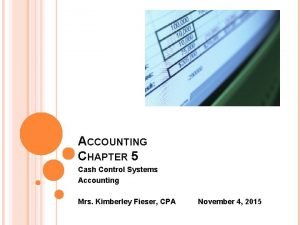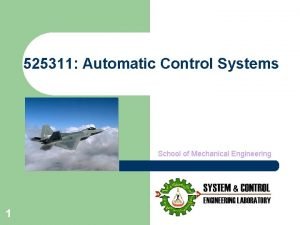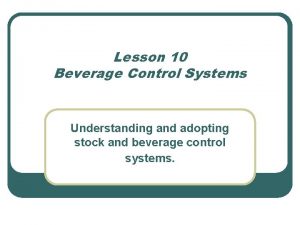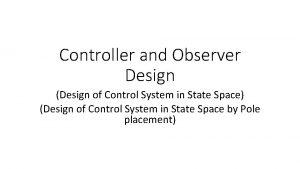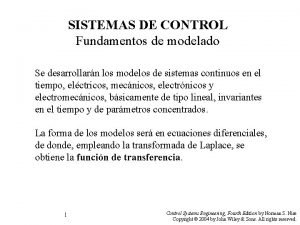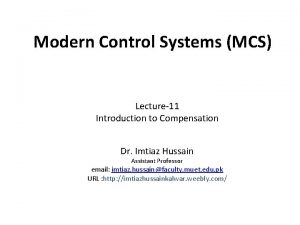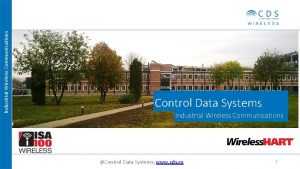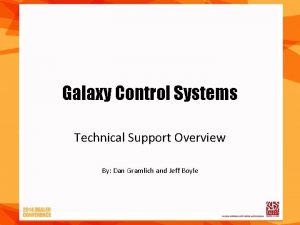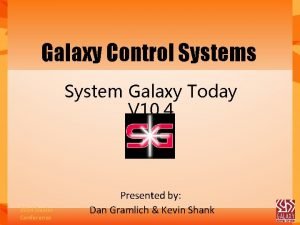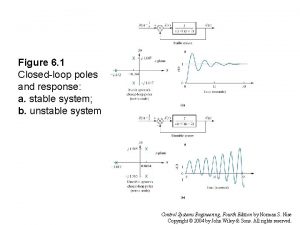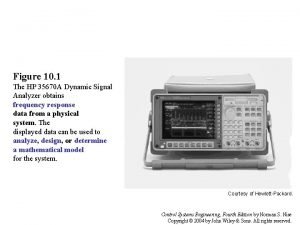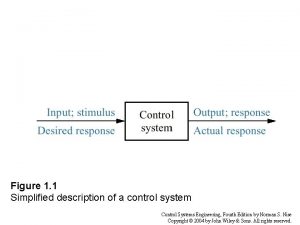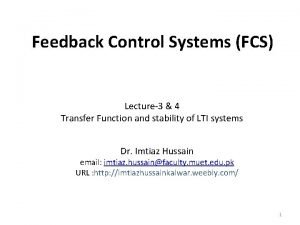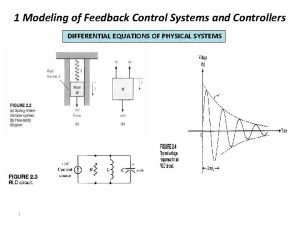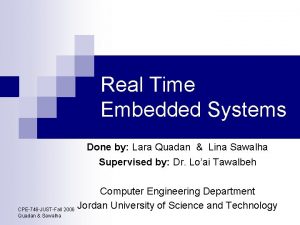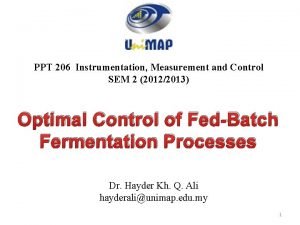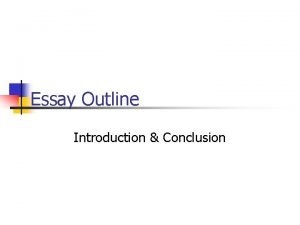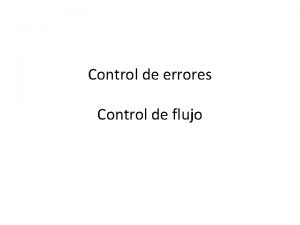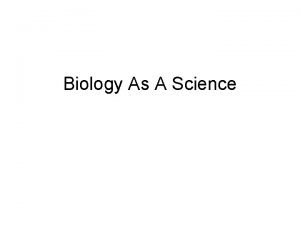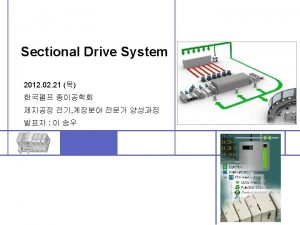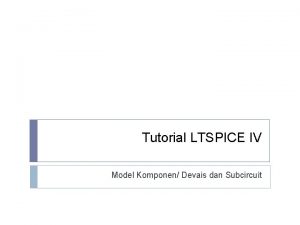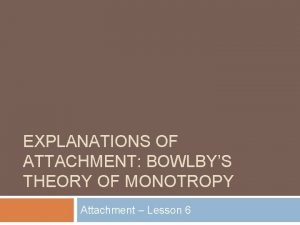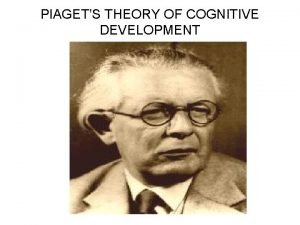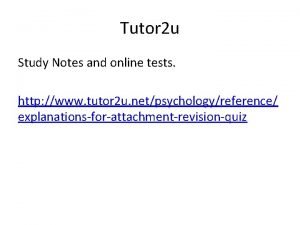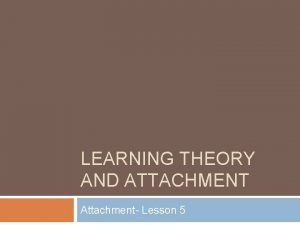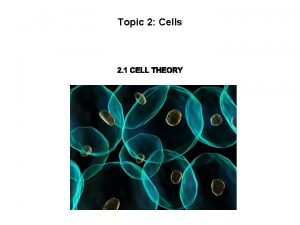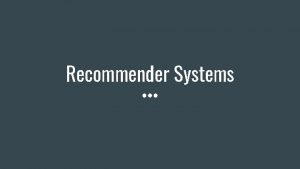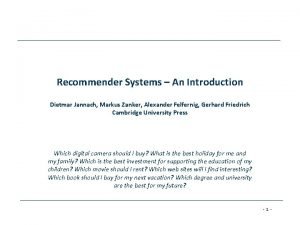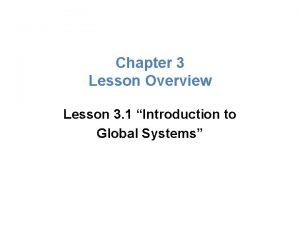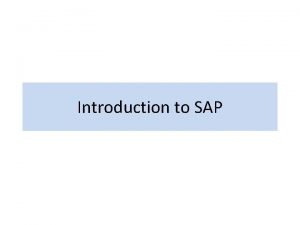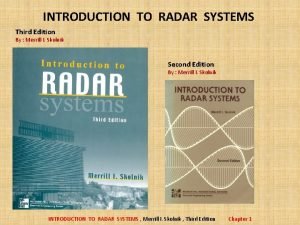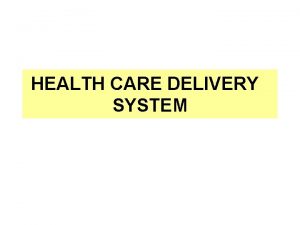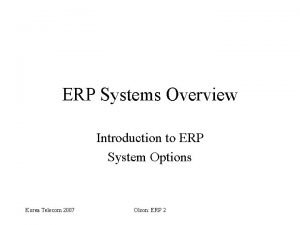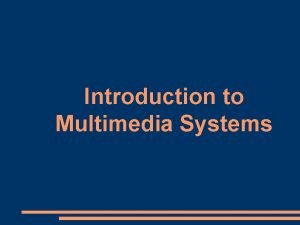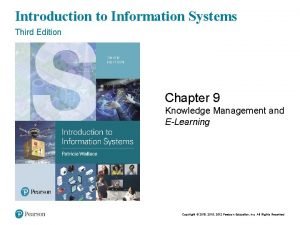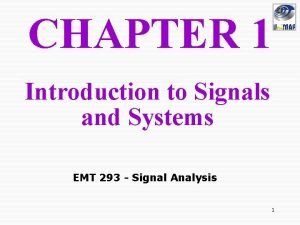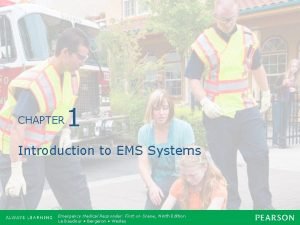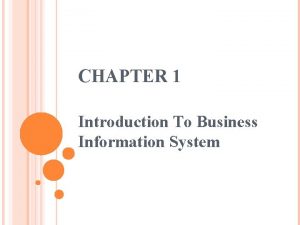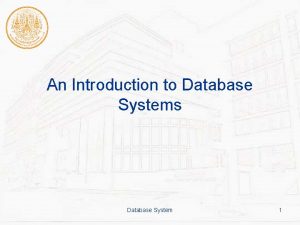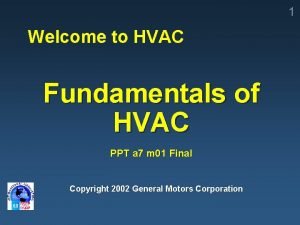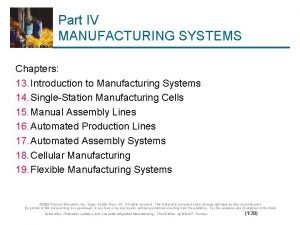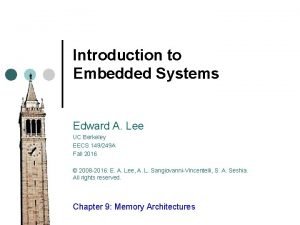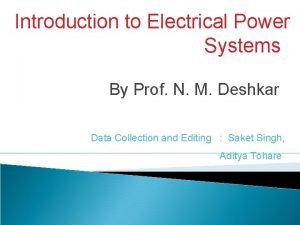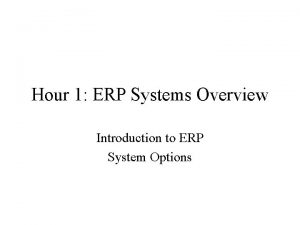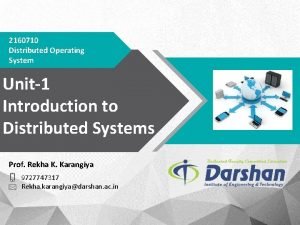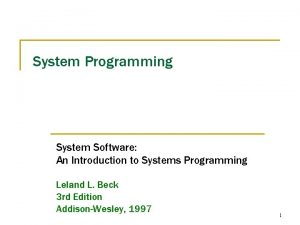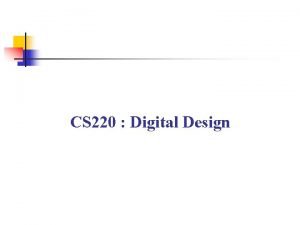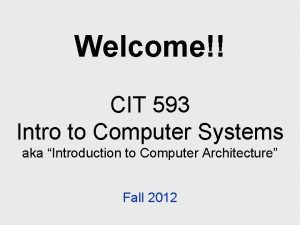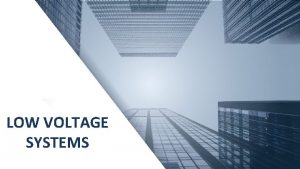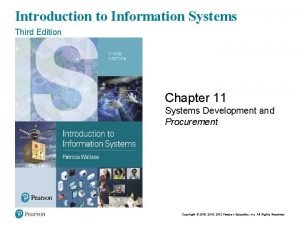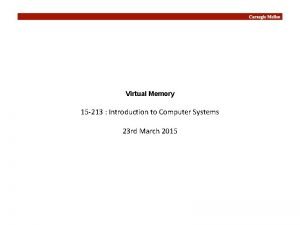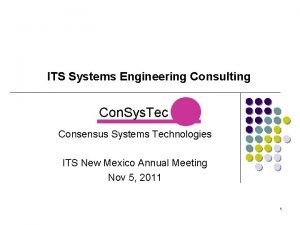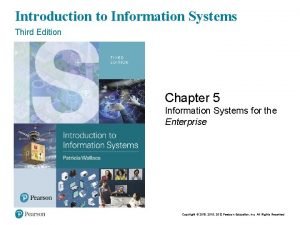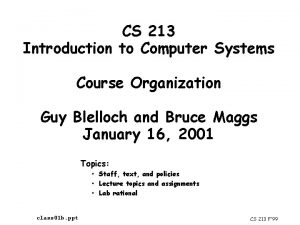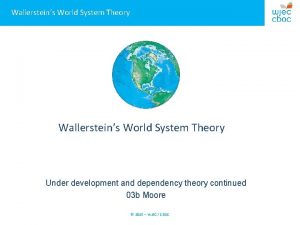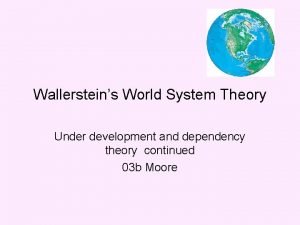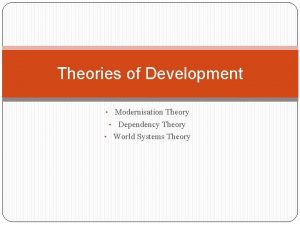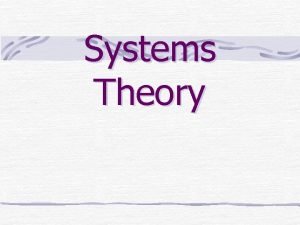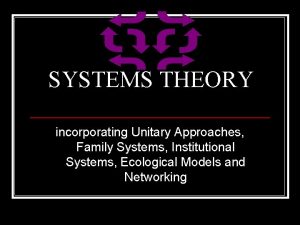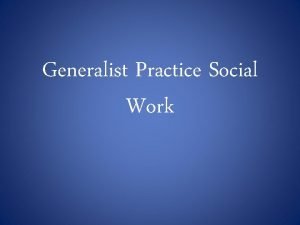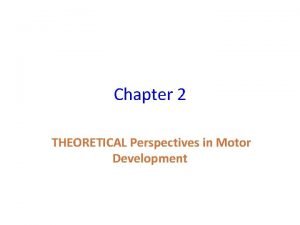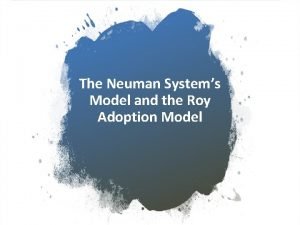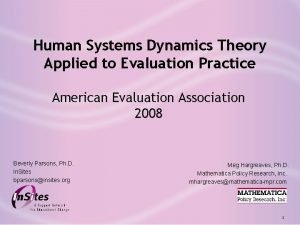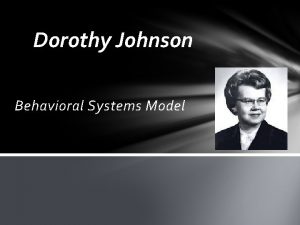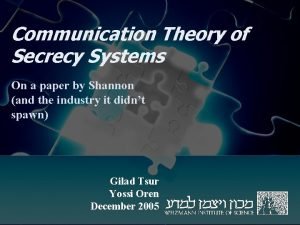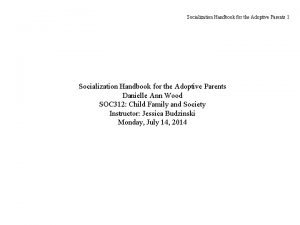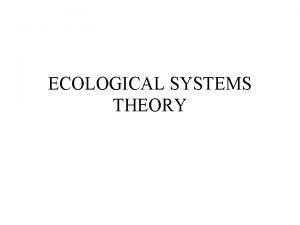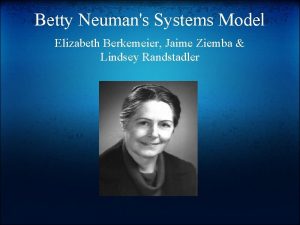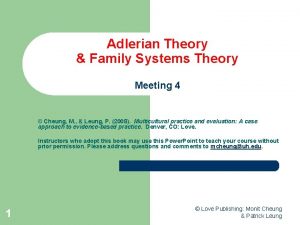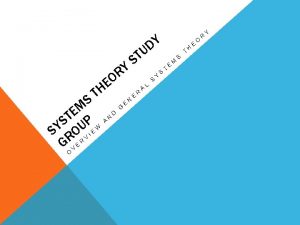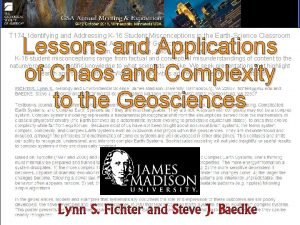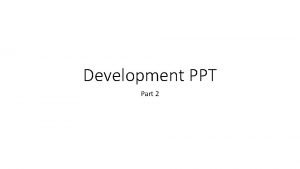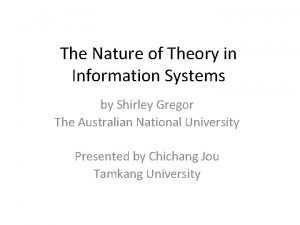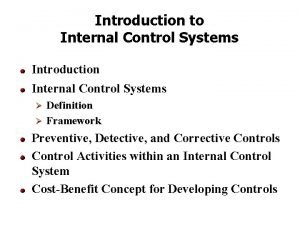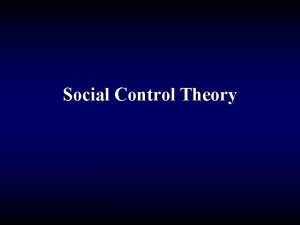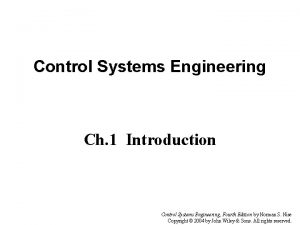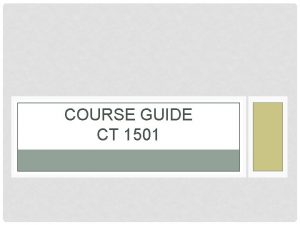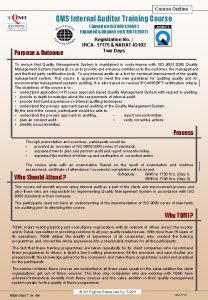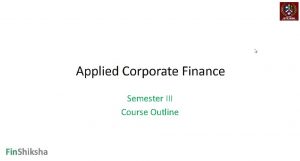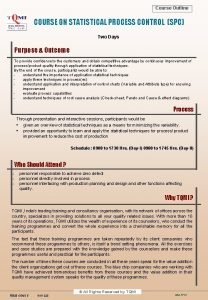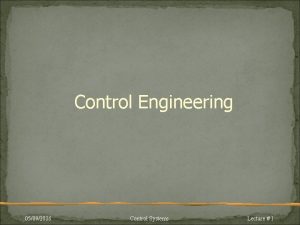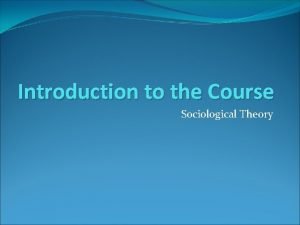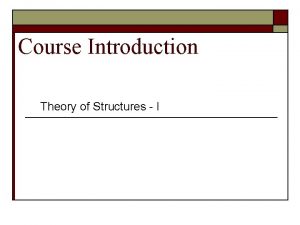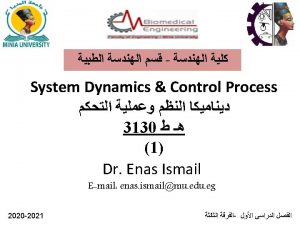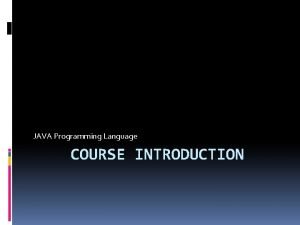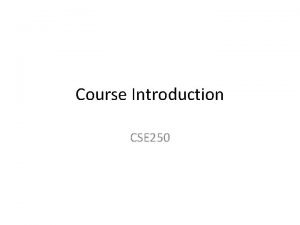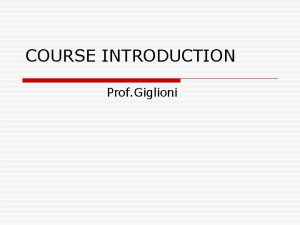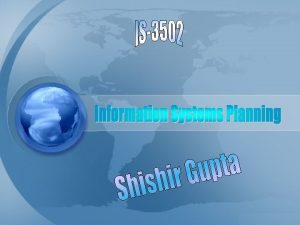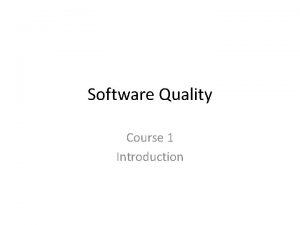Control Systems Theory Introduction 1 Outline Course Outline





























































































































![TF in zero-pole form >> sys = zpk(z, p, k) >> [z, p, k] TF in zero-pole form >> sys = zpk(z, p, k) >> [z, p, k]](https://slidetodoc.com/presentation_image_h2/35b1c5b7b6c4a5fe904c2b4928a871ea/image-126.jpg)


















































- Slides: 176

Control Systems Theory Introduction 1

Outline • • • Course Outline Recommended Books Prerequisites of the subject Basic Definitions Types of Control Systems Examples 2

Classical Control Modern Control • System Modelling • Transfer Function • Block Diagrams • System Analysis • Time Domain Analysis • Frequency Domain Analysis • Bode Plots, Nyquist Plots, Nichol’s Chart • Root Locus • System Design • Compensation Techniques • PID Control • State Space Modelling • Eigenvalue Analysis • Observability and Controllability • Solution of State Equations (state Transition Matrix) • State Space to Transfer Function • Transfer Function to State Space • Direct Decomposition of Transfer Function • Cascade Decomposition of Transfer Function • Parallel Decomposition of Transfer Function • State Space Design Techniques 3

Text Books 1. Modern Control Engineering, (5 th Edition) By: Katsuhiko Ogata. (Prof Emeritus) Mechanical Engineering University of Minnesota 2. Control Systems Engineering, (6 th Edition) By: Norman S. Nise. (Professor Emeritus) Electrical and Computer Engineering Department at California State Polytechnic University 3. Control Systems Fundamentals, (2 nd Edition) By: William S. Levine. 4

Reference Books 1. Modern Control Systems, (12 th Edition) By: Richard C. Dorf and Robert H. Bishop. 2. Automatic Control Systems, (9 th Edition) By: Golnaraghi and B. C. Kuo. 5

Prerequisites • For Classical Control Theory – Differential Equations – Laplace Transform – Basic Physics – Ordinary and Semi-logarithimic graph papers 6

Introduction to Control Systems A control system consisting of interconnected components is designed to achieve a desired purpose. To understand the purpose of a control system, it is useful to examine examples of control systems through the course of history. These early systems incorporated many of the same ideas of feedback that are in use today. Modern control engineering practice includes the use of control design strategies for improving manufacturing processes, the efficiency of energy use, advanced automobile control, including rapid transit, among others.

History Greece (BC) – Float regulator mechanism Holland (16 th Century)– Temperature regulator Watt’s Flyball Governor (18 th century)

History Water-level float regulator

History

History 18 th Century James Watt’s centrifugal governor for the speed control of a steam engine. 1920 s Minorsky worked on automatic controllers for steering ships. 1930 s Nyquist developed a method for analyzing the stability of controlled systems 1940 s Frequency response methods made it possible to design linear closedloop control systems 1950 s Root-locus method due to Evans was fully developed 1960 s State space methods, optimal control, adaptive control and 1980 s Learning controls are begun to investigated and developed. Present and on-going research fields. Recent application of modern control theory includes such non-engineering systems such as biological, biomedical, economic and socio-economic systems

What is Control System? • A system Controlling the operation of another system. • A system that can regulate itself and another system. • A control System is a device, or set of devices to manage, command, direct or regulate the behaviour of other device(s) or system(s). 12

Definitions System – An interconnection of elements and devices for a desired purpose. Control System – An interconnection of components forming a system configuration that will provide a desired response. Process – The device, plant, or system under control. The input and output relationship represents the cause-and-effect relationship of the process. Input Process Output 13

Definitions Controlled Variable– It is the quantity or condition that is measured and Controlled. Normally controlled variable is the output of the control system. Manipulated Variable– It is the quantity of the condition that is varied by the controller so as to affect the value of controlled variable. Control – Control means measuring the value of controlled variable of the system and applying the manipulated variable to the system to correct or limit the deviation of the measured value from a desired value. 14

Definitions Manipulated Variable Input or Set point or reference Controller Process Output Or Controlled Variable Disturbances– A disturbance is a signal that tends to adversely affect the value of the system. It is an unwanted input of the system. • If a disturbance is generated within the system, it is called internal disturbance. While an external disturbance is generated outside the system. 15

Types of Control System • Natural Control System – Universe – Human Body 16

Types of Control System • Manmade Control System – Aeroplanes – Chemical Process 17

Types of Control System • Manual Control Systems – Room Temperature regulation Via Electric Fan – Water Level Control • Automatic Control System – Home Water Heating Systems (Geysers) – Room Temperature regulation Via A. C – Human Body Temperature Control 18

Types of Control System Open-Loop Control Systems utilize a controller or control actuator to obtain the desired response. • Output has no effect on the control action. • In other words output is neither measured nor fed back. Input Controller Process Output Examples: - Washing Machine, Toaster, Electric Fan, microwave oven, e. t. c 19

Types of Control System Open-Loop Control Systems • Since in open loop control systems reference input is not compared with measured output, for each reference input there is fixed operating condition. Therefore, the accuracy of the system depends on calibration. • The performance of open loop system is severely affected by the presence of disturbances, or variation in operating/ environmental conditions. 20

Types of Control System Closed-Loop Control Systems utilizes feedback to compare the actual output to the desired output response. Input Comparator Controller Process Output Measurement Examples: - Refrigerator, Electric Iron, Air conditioner 21

Types of Control System Multivariable Control System Outputs Temp Humidity Pressure Comparator Controller Process Measurements 22

Types of Control System Feedback Control System • A system that maintains a prescribed relationship between the output and some reference input by comparing them and using the difference (i. e. error) as a means of control is called a feedback control system. Input + - error Controller Process Output Feedback • Feedback can be positive or negative. 23

Types of Control System Servo System • A Servo System (or servomechanism) is a feedback control system in which the output is some mechanical position, velocity or acceleration. Antenna Positioning System Modular Servo System (MS 150) 24

Types of Control System Linear Vs Nonlinear Control System • A Control System in which output varies linearly with the input is called a linear control system. u(t) Process y(t) 25

Types of Control System Linear Vs Nonlinear Control System • When the input and output has nonlinear relationship the system is said to be nonlinear. 26

Types of Control System Time invariant vs Time variant • When the characteristics of the system do not depend upon time itself then the system is said to time invariant control system. • Time varying control system is a system in which one or more parameters vary with time. 27

Types of Control System Continuous Data Vs Discrete Data System • In continuous data control system all system variables are function of a continuous time t. x(t) t • A discrete time control system involves one or more variables that are known only at discrete time intervals. X[n] n 28

Types of Control System Deterministic vs Stochastic Control System • A control System is deterministic if the response to input is predictable and repeatable. x(t) y(t) t t • If not, the control system is a stochastic control system z(t) t 29

Classification of Control Systems a ine s(L em yst l. S tro on IC LT Natural Man-made Automatic rt Manual e im linear s) tem sys Non-linear l tro on linear Closed-loop tc an Non-linear ari inv Open-loop Time variant Time invariant 30

Examples of Control Systems Water-level float regulator 31

Examples of Control Systems 32

Examples of Modern Control Systems 33

Example of Open-Loop System

Example of Closed-Loop System

Examples of Modern Control Systems (a) Automobile steering control system. (b) The driver uses the difference between the actual and the desired direction of travel to generate a controlled adjustment of the steering wheel. (c) Typical directionof-travel response.

Examples of Modern Control Systems

Examples of Modern Control Systems

Examples of Modern Control Systems

Examples of Modern Control Systems

Examples of Modern Control Systems

Examples of Modern Control Systems

Examples of Modern Control Systems

The Future of Control Systems

The Future of Control Systems

Control System Design


How to analyze and design a control system r Expected value e - Controller Actuator Error u n Disturbance Plant y Controlled variable Sensor • The first thing is to establish system model (mathematical model) 48

Mathematical modeling of Dynamic Systems 49

Mathematical Models of Systems Objectives We use quantitative mathematical models of physical systems to design and analyze control systems. The dynamic behavior is generally described by ordinary differential equations. We will consider a wide range of systems, including mechanical, hydraulic, and electrical. Since most physical systems are nonlinear, we will assume they are linear systems, which allow us to use Laplace transform methods. We will then proceed to obtain the input–output relationship for components and subsystems in the form of transfer functions. The transfer function blocks can be organized into block diagrams or signalflow graphs to graphically depict the interconnections. Block diagrams (and signal-flow graphs) are very convenient and natural tools for designing and analyzing complicated control systems.

Six Step Approach to Dynamic System Problems Define the system and its components. Formulate the mathematical model and list the necessary assumptions. Write the differential equations describing the model. Solve the equations for the desired output variables. Examine the solutions and the assumptions. If necessary, reanalyze or redesign the system.

System model Definition: Mathematical expression of dynamic relationship between input and output of a control system. Mathematical model is foundation to analyze and design automatic control systems No mathematical model of a physical system is exact. We generally strive to develop a model that is adequate for the problem at hand but without making the model overly complex. 52

Three models Differential equation Transfer function Frequency characteristic Study time-domain response Transfer function Linear system study frequency-domain response Differential Frequency Laplace equation Fourier characteristic transform 53

Modeling methods Analytic method According to A. Newton’ s Law of Motion B. Law of Kirchho ff C. System structu re and parame 54

Modeling methods System identification method Building the system model based on the system input—output signal This method is usually applied when there are little information available for the system. Input Process Output 55

Why Focus on Linear Time-Invariant (LTI) System What is linear system? -A system is called linear if the principle of superposition applies system 56

Linear Approximations

Linear Approximations Linear Systems-Necessary condition: 1. Principle of Superposition 2. Property of Homogeneity

Advantages of linear systems The overall response of a linear system can be obtained by: -- decomposing the input into a sum of elementary signals -- figuring out each response to the respective elementary signal -- adding all these responses together. Thus, we can use typical elementary signal (e. g. unit step , unit impulse, unit ramp) to analyze system for the sake of simplicity. 59

• What is time-invariant system? – A system is called time-invariant if the parameters are stationary with respect to time during system operation – Examples? 60

Establishment of differential equation and linearization 61

Differential equation Linear ordinary differential equations --- A wide range of systems in engineering are modeled mathematically by differential equations --- In general, the differential equation of an nth order system is written Time-domain model 62

How to establish ODE of a control system --- list differential equations according to the physical rules of each component; --- obtain the differential equation sets by eliminating intermediate variables; --- get the overall input-output differential equation of control system. 63

Examples-1 RLC circuit R u(t) L i(t) Input u(t) C uc(t) Output system uc(t) Defining the input and output according to which cause-effect relationship you are interested in. 64

R According to Law of Kirchhoff in electricity u(t) L i(t) C uc(t) 65

It is re-written as in standard form Generally,we set • the output on the left side of the equation • the input on the right side • the input is arranged from the highest order to the lowest order 66

Examples-2 Mass-spring-friction system Gravity is neglected. Spring k We are interested in the relationship between external force F(t) and mass displacement x(t) Define: input—F(t); output---x(t) F(t) m Displacement x(t) friction f 67

By eliminating intermediate variables, we obtain the overall input-output differential equation of the mass-spring-friction system. Recall the RLC circuit system These formulas are similar, that is, we can use the same mathematical model to describe a class of systems that are physically absolutely different but share the same Motion Law. 68

Differential Equation of Physical Systems

Differential Equation of Physical Systems Electrical Inductance Translational Spring Rotational Spring Fluid Inertia Describing Equation Energy or Power

Differential Equation of Physical Systems Electrical Capacitance Translational Mass Rotational Mass Fluid Capacitance Thermal Capacitance

Differential Equation of Physical Systems Electrical Resistance Translational Damper Rotational Damper Fluid Resistance Thermal Resistance

Exercise E 1. Please build the differential equations of the following two systems. Input Output A x B Output 73

Solutions. (1) RC circuit (2) Mass-spring system 74

Transfer function 75

Transfer Function • Transfer Function is the ratio of Laplace transform of the output to the Laplace transform of the input. Considering all initial conditions to zero. u(t) • Where Plant y(t) is the Laplace operator. 76

Transfer Function • Then the transfer function G(S) of the plant is given as U(S) G(S) Y(S) 77

Why Laplace Transform? • By use of Laplace transform we can convert many common functions into algebraic function of complex variable s. • For example Or • Where s is a complex variable (complex frequency) and is given as 78

The Laplace Transform Historical Perspective - Heaviside’s Operators Origin of Operational Calculus (1887)

Laplace Transform The Laplace transform of a function f(t) is defined as Laplace, Pierre-Simon 1749 -1827 where variable. is a complex 80

The Laplace Transform

Examples Step signal: f(t)=A • Exponential signal f(t)= 82

The Laplace Transform

The Laplace Transform

Laplace transform table f(t) δ(t) F(s) f(t) F(s) 1 1(t) t 85

Properties of Laplace Transform (1) Linearity (2) Differentiation Using Integration By Parts method to prove where f(0) is the initial value of f(t). 86

(3) Integration Using Integration By Parts method to prove ) 87

(4)Final-value Theorem The final-value theorem relates the steady-state behavior of f(t) to the behavior of s. F(s) in the neighborhood of s=0 (5) Initial-value Theorem 88

(6)Shifting Theorem: a. shift in time (real domain) b. shift in complex domain (7) Real convolution (Complex multiplication) Theorem 89

Laplace Transform of Derivatives • Not only common function can be converted into simple algebraic expressions but calculus operations can also be converted into algebraic expressions. • For example 90

Laplace Transform of Derivatives • In general • Where is the initial condition of the system. 91

Example: RC Circuit • u is the input voltage applied at t=0 • y is the capacitor voltage • If the capacitor is not already charged then y(0)=0. 92

Laplace Transform of Integrals • The time domain integral becomes division by s in frequency domain. 93

Inverse Laplace transform Definition:Inverse Laplace transform, denoted by is given by where C is a real constant。 Note: The inverse Laplace transform operation involving rational functions can be carried out using Laplace transform table and partial-fraction expansion. 94

The Laplace Transform The Partial-Fraction Expansion (or Heaviside expansion theorem) Suppose that F( s) s + z 1 The partial fraction expansion indicates that F(s) consists of ( s + p 1 ) × ( s + p 2 ) a sum of terms, each of which is a factor of the denominator. The values of K 1 and K 2 are determined by combining the individual fractions by means of the lowest common denominator and comparing the resultant numerator or coefficients with those of the coefficients of the numerator F( s) K 1 s + p 1 + K 2 before separation in different terms. s + p 2 Evaluation of Ki in the manner just described requires the simultaneous solution of n equations. An alternative method is to multiply both sides of the equation by (s + pi) then setting s= - pi, the right-hand side is zero except for Ki so that Ki ( s + pi ) × ( s + z 1) ( s + p 1 ) + ( s + p 2 ) s = - pi

Partial-Fraction Expansion method for finding Inverse Laplace Transform If F(s) is broken up into components If the inverse Laplace transforms of components are readily available, then 96

The Transfer Function of Linear Systems Example 2. 2

Calculation of the Transfer Function • Consider the following ODE where y(t) is input of the system and x(t) is the output. • or • Taking the Laplace transform on either sides 98

Calculation of the Transfer Function • Considering Initial conditions to zero in order to find the transfer function of the system • Rearranging the above equation 99

Example 1. Find out the transfer function of the RC network shown in figure-1. Assume that the capacitor is not initially charged. Figure-1 2. u(t) and y(t) are the input and output respectively of a system defined by following ODE. Determine the Transfer Function. Assume there is no any energy stored in the system. 100

Transfer Function • In general • Where x is the input of the system and y is the output of the system. 101

Transfer Function • When order of the denominator polynomial is greater than the numerator polynomial the transfer function is said to be ‘proper’. • Otherwise ‘improper’ 102

Transfer Function • Transfer function helps us to check – The stability of the system – Time domain and frequency domain characteristics of the system – Response of the system for any given input 103

Poles and zeros Poles A complex number s 0 is said to be a pole of a complex variable function F(s) if F(s 0)=∞. • Zeros – A complex number s 0 is said to be a zero of a complex variable function F(s) if F(s 0)=0. Examples: poles: -3, -4; poles: -1+j, -1 -j; zeros: 1, -2 zeros: -1 104

Case 1: F(s) has simple real poles Partial-Fraction Expansion Inverse LT Parameters pk give shape and numbers ck give magnitudes. 105

Example 1 Partial-Fraction Expansion 106

Case 2: F(s) has simple complex-conjugate poles Example 2 Laplace transform Applying initial conditions Partial-Fraction Expansion Inverse Laplace transform 107

Case 3: F(s) has multiple-order poles Simple poles Multi-order poles The coefficients corresponding to the multi-order poles are determined as 108

Example 3 Laplace transform: Applying initial conditions: s= -1 is a 3 order pole Partial-Fraction Expansion 109

Determining coefficients: Inverse Laplace transform: 110

With aid of MATLAB 1. Laplace Transform L=laplace(f) 2. Inverse Laplace Transform F=ilaplace(L) >> syms t >> L=laplace(t) L= 1/s^2 >> L=laplace(sin(t)) L= 1/(s^2+1) >> F=ilaplace(L) F= sin(t) 111

Transfer function Input u(t) LTI system Output y(t) Consider a linear system described by differential equation Assume all initial conditions are zero, we get the transfer function(TF) of the system as 112

Example 1. Find the transfer function of the RLC R L Input u(t) i(t) C uc(t) Output Solution: 1) Writing the differential equation of the system according to physical law: 2) Assuming all initial conditions are zero and applying Laplace transform 3) Calculating the transfer function as 113

Exercise Find the transfer function of the following system : 114

Transfer function of typical components Component ODE TF 115

Properties of transfer function The transfer function is defined only for a linear time-invariant system, not for nonlinear system. All initial conditions of the system are set to zero. The transfer function is independent of the input of the system. The transfer function G(s) is the Laplace transform of the unit impulse response g(t). 116

How poles and zeros relate to system response • Why we strive to obtain TF models? • Why control engineers prefer to use TF model? • How to use TF model to analyze and design control systems? • we start from the relationship between the locations of zeros and poles of TF and the output responses of a system 117

Time-domain impulse response Transfer function Position of poles and zeros j -a 0 i 0 118

Transfer function Time-domain impulse response Position of poles and zeros j b -a 0 i 0 119

Time-domain impulse response Transfer function Position of poles and zeros j b 0 0 i 120

Time-domain impulse response Transfer function Position of poles and zeros j 0 -a i 121

Transfer function: Time-domain dynamic response Position of poles and zeros j b -a 0 0 i 122

Summary of pole position & system dynamics 123

Characteristic equation -obtained by setting the denominator polynomial of the transfer function to zero Note: stability of linear single-input, single-output systems is completely governed by the roots of the characteristics equation. 124

Transfer function(TF) models in MATLAB Suppose a linear SISO system with input u(t), output y(t), the transfer function of the system is Descending power of s TF in polynomial form >> Sys = tf(num,den) >> [num, den] = tfdata (sys) 125
![TF in zeropole form sys zpkz p k z p k TF in zero-pole form >> sys = zpk(z, p, k) >> [z, p, k]](https://slidetodoc.com/presentation_image_h2/35b1c5b7b6c4a5fe904c2b4928a871ea/image-126.jpg)
TF in zero-pole form >> sys = zpk(z, p, k) >> [z, p, k] = tfdata (sys) Transform TS from zero-pole form into polynomial form >> [z, p, k] = tf 2 zp(num, den) 126

Review questions What is the definition of “transfer function”? When defining the transfer function, what happens to initial conditions of the system? Does a nonlinear system have a transfer function? How does a transfer function of a LTI system relate to its impulse response? Define the characteristic equation of a linear system in terms of the transfer function. 127

Block diagram 128

Introduction • A Block Diagram is a shorthand pictorial representation of the cause-and-effect relationship of a system. • The interior of the rectangle representing the block usually contains a description of or the name of the element, gain, or the symbol for the mathematical operation to be performed on the input to yield the output. • The arrows represent the direction of information or signal flow.

Introduction • The operations of addition and subtraction have a special representation. • The block becomes a small circle, called a summing point, with the appropriate plus or minus sign associated with the arrows entering the circle. • The output is the algebraic sum of the inputs. • Any number of inputs may enter a summing point. • Some books put a cross in the circle.

Introduction • In order to have the same signal or variable be an input to more than one block or summing point, a takeoff (or pickoff) point is used. • This permits the signal to proceed unaltered along several different paths to several destinations.

Example-1 •

Example-1

Example-2 • Draw the Block Diagrams of the following equations.

Canonical Form of A Feedback Control System

Characteristic Equation • The control ratio is the closed loop transfer function of the system. • The denominator of closed loop transfer function determines the characteristic equation of the system. • Which is usually determined as:

Example-3 1. Open loop transfer function 2. Feed Forward Transfer function 3. control ratio 4. feedback ratio 5. error ratio 6. closed loop transfer function 7. characteristic equation 8. Open loop poles and zeros if 9. closed loop poles and zeros if K=10.

Reduction techniques 1. Combining blocks in cascade 2. Combining blocks in parallel

3. Eliminating a feedback loop

Example-4: Reduce the Block Diagram to Canonical Form.

Example-4: Continue.

Example-5 • For the system represented by the following block diagram determine: 1. 2. 3. 4. 5. 6. 7. 8. Open loop transfer function Feed Forward Transfer function control ratio feedback ratio error ratio closed loop transfer function characteristic equation closed loop poles and zeros if K=10.

Example-5 – First we will reduce the given block diagram to canonical form

Example-5

Example-5 (see example-3) 1. Open loop transfer function 2. Feed Forward Transfer function 3. control ratio 4. feedback ratio 5. error ratio 6. closed loop transfer function 7. characteristic equation 8. closed loop poles and zeros if K=10.

Example-6 • For the system represented by the following block diagram determine: 1. 2. 3. 4. 5. 6. 7. 8. Open loop transfer function Feed Forward Transfer function control ratio feedback ratio error ratio closed loop transfer function characteristic equation closed loop poles and zeros if K=100.

Reduction techniques 4. Moving a summing point behind a block 5. Moving a summing point ahead a block

6. Moving a pickoff point behind a block 7. Moving a pickoff point ahead of a block

8. Swap with two neighboring summing points

Example-7 • Reduce the following block diagram to canonical form. _ +_ + + +

Example-7 _ +_ + + +

Example-7 _ +_ + + +

Example-7 _ +_ + + +

Example-7 _ +_ +

Example-7 _ +_ +

Example-7 +_

Example 8 Find the transfer function of the following block diagram R (s )

Solution: 1. Moving pickoff point A ahead of block 2. Eliminate loop I & simplify

3. Moving pickoff point B behind block

4. Eliminate loop III

Example 9 Find the transfer function of the following block diagrams

Solution: 1. Moving pickoff point A behind block

2. Eliminate loop I and Simplify feedback Not feedback

3. Eliminate loop II & IIII

Example-10: Reduce the Block Diagram.

Example-10: Continue.

Example-11: Simplify the block diagram then obtain the closeloop transfer function C(S)/R(S). (from Ogata: Page-47)

Example-11: Continue.

Block Diagram of Armature Controlled D. C Motor Ra Va La ia c eb T J t an t s n =co Vf

Block Diagram of Armature Controlled D. C Motor

Block Diagram of Armature Controlled D. C Motor

Block Diagram of Armature Controlled D. C Motor

Block diagram The transfer function relationship can be graphically denoted through a block diagram. U(s) G(s) Y(s) 173

Equivalent transform of block diagram 1 Connection in series U(s) G 1(s) U(s) X(s) G 2(s) Y(s) 174

2. Connection in parallel U(s) G 1(s) G 2(s) Y 1(s) Y(S) U(s) G(s) Y 2(s) 175

3. Negative feedback R(s) _ U(s) G(s) Y(s) R(s) M(s) Y(s ) H(s) Transfer function of a negative feedback system: 176
 Introduction to software engineering course outline
Introduction to software engineering course outline Engineering elegant systems: theory of systems engineering
Engineering elegant systems: theory of systems engineering Engineering elegant systems: theory of systems engineering
Engineering elegant systems: theory of systems engineering Introduction to analog and digital control systems
Introduction to analog and digital control systems Digital control
Digital control Half brick wall
Half brick wall Course title and course number
Course title and course number Course interne moyenne externe
Course interne moyenne externe Social psychology course outline
Social psychology course outline Mgt 351 nsu course outline
Mgt 351 nsu course outline Cgeo 702 course outline
Cgeo 702 course outline Occupational health and safety course outline
Occupational health and safety course outline Ai2.appinventor.mit.edu emulator
Ai2.appinventor.mit.edu emulator Parallel and distributed computing syllabus
Parallel and distributed computing syllabus Java course outline
Java course outline Knowledge management course outline
Knowledge management course outline Bsb51407
Bsb51407 Product-oriented syllabus
Product-oriented syllabus Occupational health and safety course outline
Occupational health and safety course outline Mba finance course outline
Mba finance course outline Phys1160 course outline
Phys1160 course outline Sysc 2004 course outline
Sysc 2004 course outline Hts course outline
Hts course outline Recruitment and selection course outline
Recruitment and selection course outline Course outline meaning
Course outline meaning Train the trainer course outline
Train the trainer course outline Agile course outline
Agile course outline Functional english course outline
Functional english course outline Outline of american literature
Outline of american literature Analytical thinking training course outline
Analytical thinking training course outline Rhcsa course syllabus
Rhcsa course syllabus Molecular biology course outline
Molecular biology course outline Operation management course outline
Operation management course outline Signal processing development kit presentation
Signal processing development kit presentation Golf course drainage products
Golf course drainage products Dbms course outcomes
Dbms course outcomes Distributed systems course
Distributed systems course Radar systems engineering course
Radar systems engineering course Distributed systems course
Distributed systems course Sentence outline
Sentence outline Introduction to banking course
Introduction to banking course Imbe introduction course v2
Imbe introduction course v2 Ron had a course introduction
Ron had a course introduction Cleft sentences formula
Cleft sentences formula Awe aldermaston
Awe aldermaston A brief introduction to spectral graph theory
A brief introduction to spectral graph theory Crash course sliding filament theory
Crash course sliding filament theory Life course theory crime
Life course theory crime Payment systems outline
Payment systems outline Payment systems outline
Payment systems outline Payment systems outline
Payment systems outline Support control and movement lesson outline
Support control and movement lesson outline Structure movement and control answer key
Structure movement and control answer key Decision support systems and intelligent systems
Decision support systems and intelligent systems Embedded systems vs cyber physical systems
Embedded systems vs cyber physical systems Version control systems industry
Version control systems industry Systemactio
Systemactio Theories of motor control
Theories of motor control Integrated control safety system
Integrated control safety system Computer control of manufacturing systems
Computer control of manufacturing systems Rcs remote control systems
Rcs remote control systems Feedback control of computing systems
Feedback control of computing systems Control systems in plants
Control systems in plants Dominant poles
Dominant poles Chapter 5 cash control systems
Chapter 5 cash control systems Transactions and concurrency control in distributed systems
Transactions and concurrency control in distributed systems Advantage of stepper motor
Advantage of stepper motor Abb control system
Abb control system Control systems modeling
Control systems modeling Basics of instrumentation and control ppt
Basics of instrumentation and control ppt What is goal congruence in management control system
What is goal congruence in management control system Accu grade
Accu grade A servomechanism is a feedback control
A servomechanism is a feedback control Controllability matrix
Controllability matrix Concurrency control and recovery in database systems
Concurrency control and recovery in database systems Dynamic response in control systems
Dynamic response in control systems Cost control systems
Cost control systems Part 5 preparing a check stub and check
Part 5 preparing a check stub and check Biomedical control systems
Biomedical control systems Chapter 5 cash control systems answer key
Chapter 5 cash control systems answer key Mechanical engineering control systems
Mechanical engineering control systems Beverage control systems
Beverage control systems Bass-gura formula
Bass-gura formula Part six recording bank and petty cash transactions answers
Part six recording bank and petty cash transactions answers Sistema mecanico rotacional
Sistema mecanico rotacional Control systems
Control systems Control data systems inc
Control data systems inc System galaxy tech support
System galaxy tech support Galaxy control systems dealer
Galaxy control systems dealer Control system engineering
Control system engineering Control system engineering
Control system engineering Control systems engineering
Control systems engineering Transfer function
Transfer function Control systems
Control systems Embedded control systems examples
Embedded control systems examples Computer control of fermentation process ppt
Computer control of fermentation process ppt Conclusion paragraph outline
Conclusion paragraph outline 5 paragraph essay outline
5 paragraph essay outline Translational research institute on pain in later life
Translational research institute on pain in later life Product control
Product control Reynold’s transport theorem
Reynold’s transport theorem Stock control e flow control
Stock control e flow control Control volume vs control surface
Control volume vs control surface Positive vs negative controls
Positive vs negative controls Positive and negative controls
Positive and negative controls Hdlc adalah
Hdlc adalah Control de errores
Control de errores Negative control vs positive control examples
Negative control vs positive control examples Error control and flow control
Error control and flow control Scalar control vs vector control
Scalar control vs vector control Control c control v
Control c control v Social releasers psychology
Social releasers psychology Outline piaget's theory of cognitive development
Outline piaget's theory of cognitive development Outline bowlby's theory of attachment 6 marks
Outline bowlby's theory of attachment 6 marks Learning theory attachment
Learning theory attachment Outline the cell theory
Outline the cell theory Introduction of system analysis and design
Introduction of system analysis and design Introduction to recommender systems
Introduction to recommender systems Markus zanker
Markus zanker Introduction to operating systems
Introduction to operating systems Chapter 3 lesson 1 introduction to global systems
Chapter 3 lesson 1 introduction to global systems Sap systems introduction
Sap systems introduction Introduction to radar systems 3rd edition pdf
Introduction to radar systems 3rd edition pdf Introduction to healthcare delivery systems
Introduction to healthcare delivery systems Introduction to information systems 6th edition
Introduction to information systems 6th edition Erp system introduction
Erp system introduction Content management system introduction
Content management system introduction White-collar workers คือ
White-collar workers คือ Multimedia system definition
Multimedia system definition Introduction to information systems 3rd edition
Introduction to information systems 3rd edition Introduction to management information systems 5th edition
Introduction to management information systems 5th edition Pxdes expert system
Pxdes expert system Introduction to signals and systems
Introduction to signals and systems Introduction to ems
Introduction to ems User productivity system
User productivity system Introduction to accounting information system
Introduction to accounting information system An introduction to database systems
An introduction to database systems Introduction to global systems
Introduction to global systems Ppt
Ppt Introduction to manufacturing systems
Introduction to manufacturing systems Introduction to embedded systems lee seshia solution manual
Introduction to embedded systems lee seshia solution manual Introduction to electrical power systems
Introduction to electrical power systems Introduction to erp systems
Introduction to erp systems Processor pool model
Processor pool model System software: an introduction to systems programming
System software: an introduction to systems programming 101101-100111
101101-100111 Cit 593
Cit 593 Introduction to low voltage systems
Introduction to low voltage systems Introduction to information systems 3rd edition
Introduction to information systems 3rd edition 15-213 introduction to computer systems
15-213 introduction to computer systems Ntcip
Ntcip Introduction to information systems 3rd edition
Introduction to information systems 3rd edition 15-213 introduction to computer systems
15-213 introduction to computer systems Wallerstein model
Wallerstein model Wallersteins world system theory
Wallersteins world system theory Modernization theory vs dependency theory
Modernization theory vs dependency theory Systems theory example
Systems theory example Pincus and minahan (1973 reference)
Pincus and minahan (1973 reference) Wallerstein's world systems map
Wallerstein's world systems map Micro system social work
Micro system social work Dynamical systems theory motor development
Dynamical systems theory motor development Neuman systems model
Neuman systems model Forward thrust capital ap human geography
Forward thrust capital ap human geography Human systems dynamics theory
Human systems dynamics theory Behavioral systems theory
Behavioral systems theory Communication theory of secrecy systems
Communication theory of secrecy systems Bronfenbrenner's ecological systems theory
Bronfenbrenner's ecological systems theory Bronfenbrenner's ecological systems theory
Bronfenbrenner's ecological systems theory Exosystem
Exosystem Using the neuman systems model for best practices
Using the neuman systems model for best practices Family systems theory powerpoint
Family systems theory powerpoint General systems theory
General systems theory Systems theory
Systems theory Wallerstein model
Wallerstein model The nature of theory in information systems
The nature of theory in information systems Internal control introduction
Internal control introduction Labeling theory
Labeling theory








